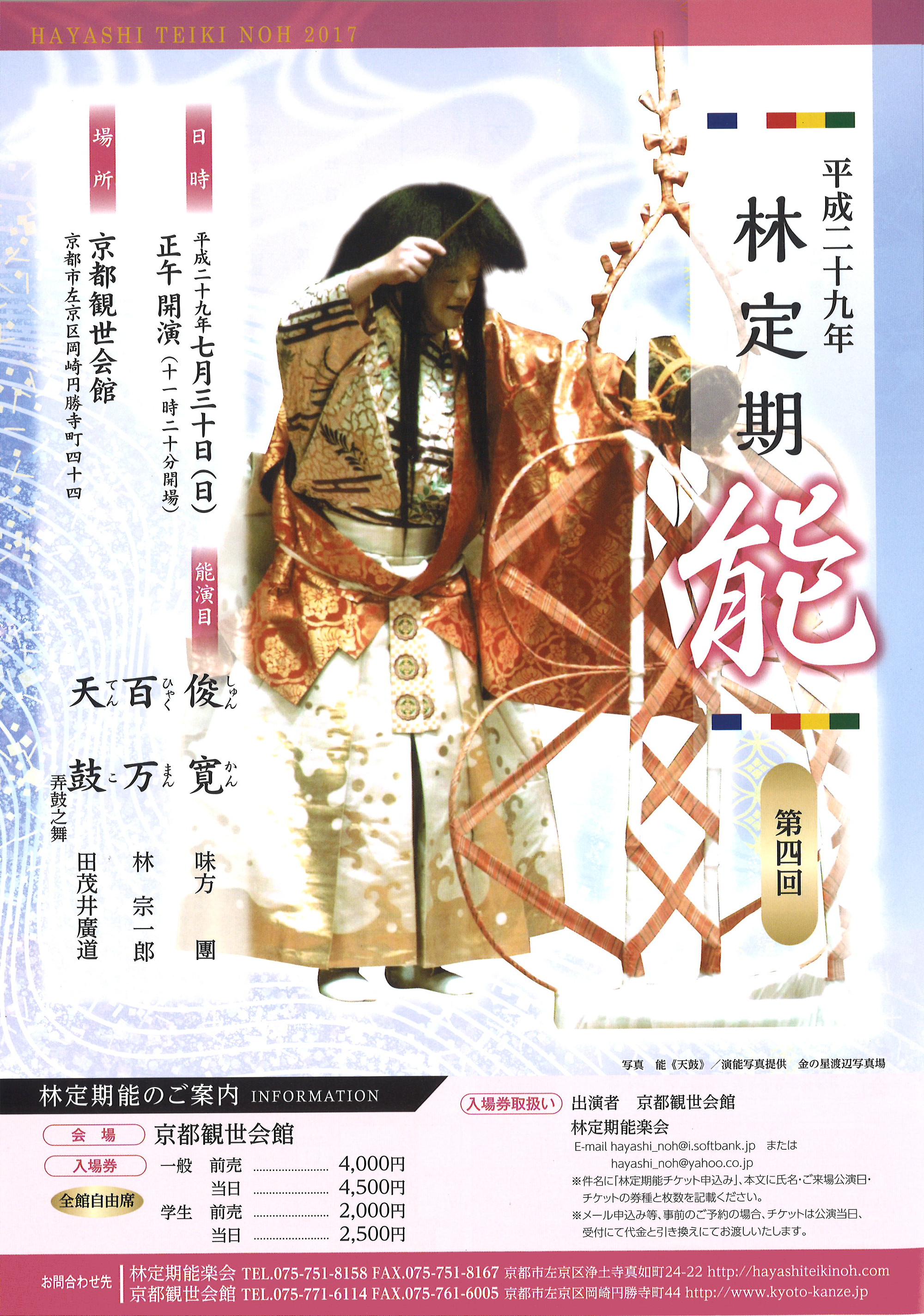林定期能 第四回 The 4th Hayashi Teiki Noh
2017年 7月 30日 (日) 12:00開演(開場11:20)
- 演目
-
能「俊寛」
Noh"Shunkan"
シテ(俊寛僧都):味方團
ツレ(康頼・成経):河村和晃、樹下千慧
ワキ(赦免使):福王知登
Shite:Madoka Mikata
Tsure:Kazuaki Kawamura , Chisato Jyuge
狂言「口真似」 Kyoden"Kuchimane"シテ(太郎冠者):茂山七五三
Shite:Shime Shigeyama
能「百万」 Noh“Hyakuman”シテ(百万):林宗一郎
子方(百万の子):林彩子
Shite”Hyakuman”: Soichiro Hayashi
Kokata”Boy”:Ayako Hayashi
能「天鼓 弄鼓之舞」 Noh"Tenko Rook no Mai"シテ:田茂井廣道
■弄鼓ノ舞(ろうこのまい):
楽の調子を盤渉(ばんしき)にあげる(笛のキーをあげる)ことで管絃講による弔いの厳粛なムードを、鼓に舞い戯れる無邪気な天鼓の喜びが表現される。
Shite:Hiromichi Tamoi
■Rouko no Mai
By changing the flute key up, the joy of innocent Tenko who dances with a drum is expressed instead of the solemn atmosphere of the funeral by the Buddhist memorial service using wind and string instruments.
- 会場
- 京都観世会館
- 料金
- 一般前売:¥4,000 一般当日:¥4,500 学生前売:¥2,000 学生当日:¥2,500
能「俊寛」
12世紀に実在した僧。
時の権力者、平清盛の一門討伐の密議に加わった罪で、鬼界ヶ島へと配流された。能のストーリーは、鬼界ヶ島へと配流された後の話となる。
俊寛と共に流罪となった成経(なりつね)・康頼(やすより)の3人は、水を酒に見立て、共に今の境遇を嘆きながら暮らしている。
そこに、平清盛の娘で中宮となった徳子の御安産の祈祷の大赦があった。赦免使が島に到着し、赦免状を示すと、そこに俊寛の名前だけがない。
赦免された二人を乗せ、取り乱し追いすがる俊寛を無情にも残し、赦免使は舟を出す。
取り残された俊寛の絶望、哀れさ、人間の弱さを印象させる演目となっている。
能「百万」
世阿弥作。男(ワキ)が、拾った少年(子方)を伴い、嵯峨清凉寺大念仏にやってくる。
そして、門前の者(アイ)に何か面白い物を見せて欲しいというと、門前の者は、「百万(人名)」という女物狂いが良いであろうと呼び出す。
百万は念仏を唱え出すと、物狂いの状態の中で、子を思う気持ちを述べ、仏に祈る。その舞姿に少年は母と気付き、親子の再会を果たす。
百万は喜びの涙に咽び、子どもと共に奈良へと帰ってゆく。
百万は曲舞の名手であった女性芸能者である。その百万をヒロインに据え、我が子を探し求める母親が、春の嵯峨野を舞台に芸尽くしを見せる能である。
[大念仏-だいねんぶつ]
大勢の人が集まって大声で念仏を唱える行事のこと。
嵯峨清凉寺の大念仏は1279年に始められたと伝えられ、多くの人が「雲のごとくにのぞみ、星のごとくに連なりて群集」したと伝えられている。
能「天鼓 弄鼓之舞」
中国、後漢(ごかん25-220)の頃、王伯・王母(おうはく・おうぼ)という夫婦がいた。王母は天より鼓が降りる夢を見た為、産まれた子供に「天鼓」という名前をつける。その後、天より本物の鼓が降り、その音の良さはいつしか帝の耳にも届くほどのものであった。帝は鼓を献上するように命じるが、天鼓は鼓を惜しみ、鼓と共に山中深くに隠れる。ほどなくして探し出された天鼓は呂水(ろすい)に沈められ、鼓は内裏へと召された。
しかし、鼓は誰が打っても鳴らなくなる。
帝は父王伯を勅命で内裏に呼び出し、鼓を打つよう命じる。王伯は辞退するも叶わず、子を思い、悲しみのうちに鼓を打つと、鳴らない鼓が美しい音で鳴るのであった。
帝はこの親子の情愛に心を打たれ、王伯に宝を与え家へ帰し、天鼓は管絃講(音楽による法要)にて弔う事にする。
勅に背き天罰に沈んだ天鼓は御弔いの有り難さに水面に姿を現す。そして御代のありがたさに喜び鼓を打ち、楽を舞うと夜明けと共に消えていくのだった。
Noh “Shunkan”
A priest who actually existed in the 12th century.
He was exiled to Kikaigashima Island on a charge of participating in a secret conference to destroy a clan of Taira no Kiyomori, an authority at that time. The plot of this Noh is based on the story after Shunkan was exiled to Kikaigashima.
The three people, Shunkan, Naritsune and Yasuyori, who were exiled with him, use water to resemble sake and live together deploring their current circumstances.
Meanwhile, there was an amnesty granted due to a prayer for a safe delivery for Taira no Kiyomori’s daughter, Tokuko, who became an empress.
A messenger arrives on the island and shows the letter of amnesty; however, only Shunkan’s name is not there. The messenger departs from the ship with the two who were granted amnesty, cruelly leaving Shunkan who is in a panic and begs.
This is a performance which provides the impression of left-behind Shunkan’s desperation, pity and humanity’s weakness.
Noh“Hyakuman”
Written by: Zeami
A man (Waki) comes to *Dainenbutsu held in Saga Seiryouji Temple with a boy (Kokata) he picked up.Then, the man asks the gate keeper (Ai) to show them something interesting and the gate keeper thinks an insane woman, Hyakuman, would be good; therefore, he calls her. Hyakuman was in an insane state since she once was bereaved of her husband and was separated from her son.
As Hyakuman recites the Buddhist prayer, she expresses the feelings for her son in a frantic status and prays to Buddha.
The boy sees her dancing and realizes she is his mother, and the mother and the son reunite. Hyakuman sobs tears of pleasure and returns to Nara with her child.
Hyakuman is a female performer who was famous for recitative dance. This is a Noh performance, featuring Hyakuman, in which a mother who seeks for her child shows different kinds of arts in spring Sagano.
*Dainenbutsu
This is an event in which people gather and recite Buddhist prayers.
It is said that Dainenbutsu held in Saga Seiryouji Temple started in 1279 and it is also said that many people “hoped as high as clouds and gathered like stars”.
Noh “Tenko Rouko no Mai”
In China, at the time of the Later Han Dynasty (25-220), there was a couple named Ouhaku and Oubo. Oubo names her born child “Tenko” since she saw a dream of a drum falling from the sky. (In Japanese “ten” means the sky, heaven, divine and etc. and “ko” means a drum.) Later, a real drum falls from the sky and the sound of it was so beautiful that it reached the emperor’s ears. The emperor orders Tenko to present the drum to him, but Tenko feels reluctant to part with the drum and hides in the deep mountain with the drum.
Before long, the located Tenko is sunken in the river Rosui, and the drum is sent to the Imperial Palace. However, no matter who strikes the drum, it won’t make a sound. The emperor summons the father Ouhaku to the Imperial Palace as an imperial commander, and orders him to strike the drum. Ouhaku refuses but it’s not accepted; therefore, he strikes the drum in sorrow thinking of his child, then the drum that wouldn’t make a sound now makes a beautiful sound. The emperor is touched by the love of this father and son, gives Ouhaku a treasure and sends him home, then decides to hold a funeral for Tenko in Kangenko (a Buddhist memorial service with music).
Tenko who disobeyed the imperial decree and was sunken in divine punishment appears on the surface of the water due to the appreciation for the funeral.
Then he strikes the drum for the appreciation of the reign, dances to the music and disappears at the crack of dawn.





